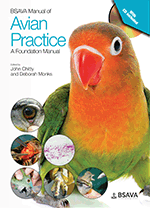
Full text loading...

Anaesthesia is utilized for a variety of reasons in avian species. This chapter provides insight into the complex decision making process regarding when or when not to employ the use of anaesthesia as well as practical guidance on performing anaesthesia. Quick reference guide: Avian intubation.
Basic anaesthesia, Page 1 of 1
< Previous page | Next page > /docserver/preview/fulltext/10.22233/9781910443323/9781910443323.16-1.gif

Full text loading...













